Life With THX In Hollywood Part 1 | This article first appeared in
|
| Written By: Paul Rayton, senior projectionist at the Hollywood Galaxy 6, Hollywood Boulevard, Hollywood, USA. | Issue 51 - January 1997 |
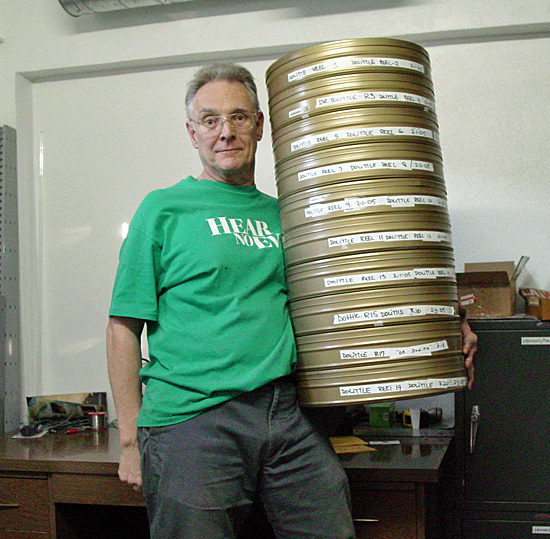 Paul Rayton at the Egyptian Theatre, 2005. The 70mm cans are empty, you better believe it. Paul Rayton at the Egyptian Theatre, 2005. The 70mm cans are empty, you better believe it.The THX Concept The THX concept was born in 1980 out of George Lucas' desire to create the ultimate theatre experience. His goal was -- and remains -- to assure that the quality of the original picture and sound of a film is delivered into each and every venue so that audiences can enjoy films as the filmmaker intended. Following three years of research and development, the first THX Sound System was installed in two commercial movie theatres in 1983 for the release of "Return of the Jedi" amongst 17 x 70mm and 6-track Dolby Stereo prints in the Los Angeles area. For much of the moviegoing public, there is a considerable mystery about what REALLY is in a "THX". And, actually, THX is more a set of guidelines and specifications than proprietary equipment. Following the specifications will enable a given cinema to reproduce sound through components that have met certain levels for performance (based on tests performed by the THX division of Lucasfilm), which will theoretically make for high quality performance in "your local THX cinema". • Go to Life With THX In Hollywood Part 2 • Go to Paul Rayton In Conversation The letters comprising the "THX" name and logo are now almost commonplace. They are seen in theatres, of course, but now can be seen at the end of some films. They are also increasingly seen on high-end video systems and even videotapes. The THX concept was originally developed as an integrated approach toward improving the overall sound experience in movie theatres. These recent diversifications into "Home THX" and the application of THX to videotapes are demonstrations of commercialism which (in my opinion) can have possibly less-than-beneficial results. More about that later on. As time has gone by, over the last several years, Hollywood has obsessed more and more on sound, and left the picture situation almost forgotten. Not completely forgotten, but almost! But truly, I have had shows (special screenings) where I could see an obvious problem on the screen...but the post-production personnel were so worried about a perceived 1/2 decibel level adjustment in a stage channel that they never even saw the visual problem. This "blindness" is quite hilarious, really, when a significant number of audio professionals feel that, in the main, most people will only perceive level differences of about 2 dB! A few years ago, THX put out some publicity buttons, saying "Digital Sound in a THX Theatre -- The Ultimate Film Experience". What they forgot, at that time, was that the TRUE ULTIMATE cinema experience would be to use 70mm as the picture source! | More in 70mm reading: |
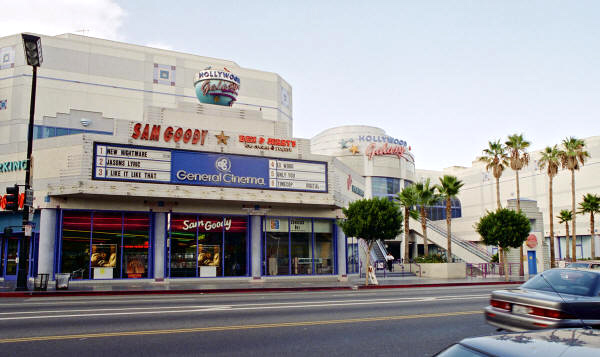 Paul Rayton, is senior projectionist at the Hollywood Galaxy 6, Hollywood Boulevard, Hollywood, USA. Picture by Thomas Hauerslev, 1994 Paul Rayton, is senior projectionist at the Hollywood Galaxy 6, Hollywood Boulevard, Hollywood, USA. Picture by Thomas Hauerslev, 1994I'll give you a quick summary of my theatre, its location and equipment, and then tell a bit more about Life With THX. My cinema, the Hollywood Galaxy 6, is a fairly new (opened Nov., 1991) multi-screen operation. We are located in the heart of Hollywood, just one block west of Grauman's Chinese theatre [now called "Mann's" Chinese, reflecting the name of the man and the company presently operating the place]. The Chinese is one of the most famous cinemas in the world. Also nearby, on the other side of Hollywood Blvd., is the El Capitan, which the Disney studios use as their west coast showcase location. The El Capitan often presents films with an accompanying live stage show. And, several blocks away, on Sunset Blvd., you will also find the Cinerama Dome theatre. As you can see, we are in prestigious company. And our customers tend to be from "show biz" fields, too. Directors, Producers, actors and actresses, and people from all the other crafts involved in making films join the public walking in our doors. I've even seen Tom Holman, who created the "THX" concepts and whose name is the "TH" in THX, watching films at our cinema. (I worry when I see him here: will we be somehow criticized at his next seminar? He usually doesn't mention specific names, but he does talk about bad experiences he observes, so it keeps us on the alert. I believe he's been reasonably pleased by conditions at the Galaxy.) With all the historic and famous cinemas nearby, we must offer something special, too, which we try to do with top notch images and sound. We -- all of these Hollywood cinemas -- also operate a little bit differently than many cinemas in other parts of the country (and the world) because: we are so near to the studios, we are visited by projection engineers and sound engineers VERY often, and our systems are probably adjusted ("tweaked", they sometime say) much more frequently than anywhere else in the world! | |
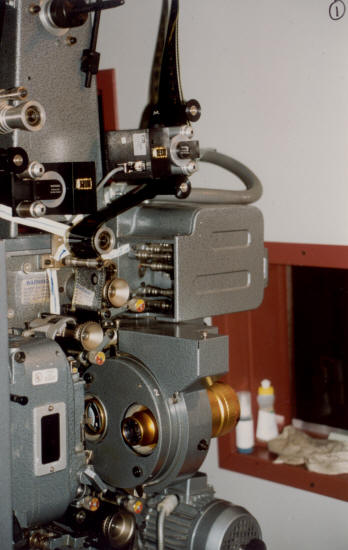 Cinemeccanica projector with a 70mm DTS reader. Cinemeccanica projector with a 70mm DTS reader. The 6 screens of my cinemas are all operated with Cinemeccanica projectors. We have 3 "THX"-equipped screens, and each of them use the "V-8" projector, which is dual 35-70mm capable. Each of these have about 520 seats. The other, smaller, cinemas use "V-5" machines, and are not THX. All 6 screens have curtains, all 6 can play DTS digital, plus we have 2 with Dolby SR.D and one SDDS. The SR.D and SDDS are placed in the THX houses, cohabiting with DTS. I presume that most readers of this article understand reasonably well what is THX, but for anyone not acquainted, here is a brief summary: the THX system is primarily three things: • A large, solid wall, built immediately behind the screen surface, with loudspeakers mounted into it; • A sound system "crossover network" at the amplifier rack that takes the various audio elements, separates out the lower and higher frequency components, and directs those to the appropriate amplifiers and speakers; and • A set of architectural, electronic, and acoustic specifications which are incorporated into the auditorium, either during original construction, or later on, in a "retrofit". That's basically IT. That's the THX system. There are two other things to keep in mind, though: • All amplifiers and speakers must be "approved" by the THX offices; and • The various cinemas must be periodically re-certified by THX if they wish to continue to be able to advertise the film as playing "in THX". This is because, even though proper equipment may have been originally installed, it may have changed and/or degraded its performance as time passes. Re-certification allows for corrections to be made if something goes out of compliance. As you can see, the THX system is thus, largely, maintenance free once it is installed and certified. There's not much adjustment to do to it, assuming it is receiving good information from the projector sound pickup system(s) and that all speakers are working correctly. If you turn off the "THX Monitor", the device which also contains the THX crossover device, you lose ALL sound, and you will quickly be notified of BIG problems with your show! With the advent of the new digital processes -- all of which can deliver a "knockout punch" to your speakers if you let them! -- we have had much more trouble with speakers than we did a few years ago. | |
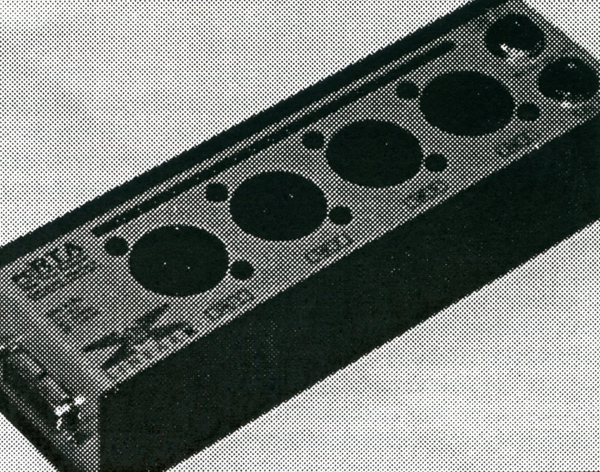 A 4-michrophone multiplexer. Picture by Paul Rayton. A 4-michrophone multiplexer. Picture by Paul Rayton.The most common problem is a damaged high-frequency driver. If this happens to the center channel, you can lose all intelligibility of dialogue and may have to shut down to replace it. (Virtually all dialogue comes through the center channel.) The most notorious recent event like this happened next door at the Chinese Theatre (thank God!), during the invitational premiere of Schwartzenegger's “Eraser”. A loud sound of some sort, in the middle of the film, burned out the high frequency driver of the center channel. Dialogue was totally muffled, being heard only through the low frequency (below 500 Hz) components of the center channel. Needless to say, within seconds, dozens (or so it seemed) of Warner Brothers executives were in the projection room, and...well, it's not a situation you'd ever want to be in! Usually, failure isn't so catastrophic that we must shut down, and we can replace the problem driver during an intermission (if time permits), or the following morning. The second most-common problems would probably be found in the sub-woofer(s). With the many explosions and blasts, and loud music, found in commercial films these days, the subwoofers get a good workout. Sometimes, their internal protective devices (if any) just don't do the job. Again, it's the dynamic range of the digital tracks (along with the apparent desire of producers and directors to deafen the audience) that makes this happen. Subwoofer power amplifiers can give up, and/or their speaker cones can rip. The THX crossover system is happy as can be to pass all these loud, wide-ranging signals along to the speakers, because it (the THX crossover) isn't designed as a "limiter". It is intended to pass on the best information possible to the amps and speakers on down the line. And so it does, with these sometimes troublesome results! In our Galaxy THX installations, all the speakers are easy to reach -- if you are a monkey! We humans, on the other hand, need to get up on rather long ladders for access. This design may assist in better THX sound, but it doesn't make the repair process simple. However, it also serves as theft protection for equipment backstage. Fortunately, counting all our 6 screens, we only have to climb up anywhere about every 3 or 4 month. | |
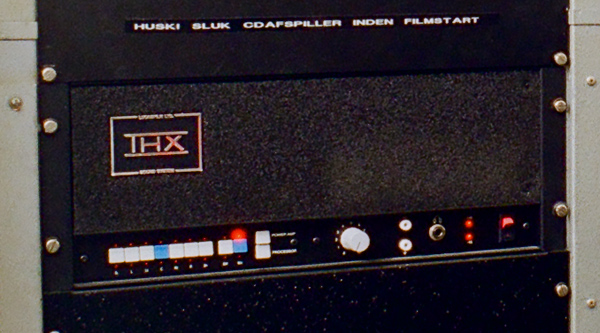 19" rack-mounted THX Crossover unit. Picture: Thomas Hauerslev, 2000 @ Imperial Bio, Copenhagen, Denmark 19" rack-mounted THX Crossover unit. Picture: Thomas Hauerslev, 2000 @ Imperial Bio, Copenhagen, DenmarkI myself keep a Component Engineering Co. pink noise generator card at the cinema. It includes an audio spectrum tone generator so that I can check each channel's operation. If I suspect a damaged driver somewhere, I can usually locate the problem rapidly, and replace it with one of the 3 spare high-frequency drivers we keep on hand for such cases. Another aspect to the operation of THX is how it is adjusted. The THX crossover has basically no adjustments; as noted before, it is a pass-along-the-information device. And of course, the THX wall behind the has no "adjustments". Where things get really interesting, however, is the adjustments and settings for what goes into the THX crossover, and who makes those adjustments. As mentioned earlier, with the proximity of the major studios, we get visited quite often by representatives of the studios and/or the various sound companies. The problem is, there is no real, true, exactly standardized way to measure and set up something "alive" like sound waves bouncing around in a room. To be continued in The 70mm Newsletter issue 52. | |
 • Go to Life With THX In Hollywood Part 1 • Go to Life With THX In Hollywood Part 2 | |
| Go: back - top - back issues Updated 19-05-25 |
